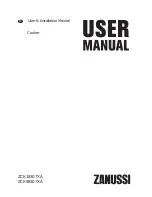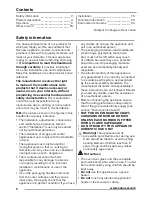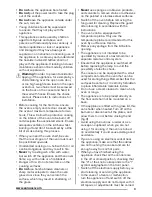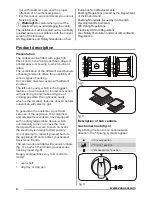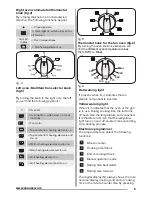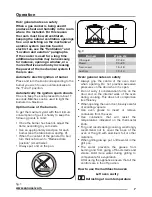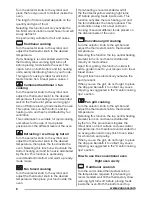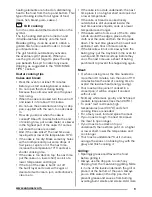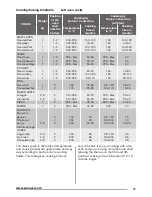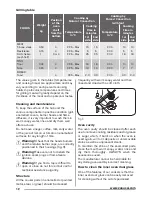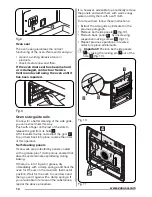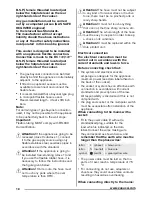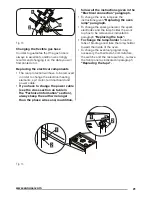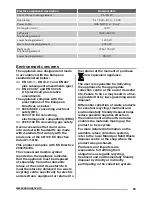
9
www.zanussi.com
heating elements are turned on, distributing
heat to the food from the top and bottom. This
type of baking is ideal for all types of food
(meat, fish, bread, pizza, cakes..).
Grill cooking
Turn the commutator/thermostat knob on the
symbol.
The top heating element is turned on and
it distributes heat directly onto the food.
Besides grilling, it can be used to obtain a
golden finish onto cooked foods or to toast
your bread slices.
The grill function automatically activates
the eventual spit (if present). When you
use the grill, do not forget to place the drip
pan beneath the spit to collect any sauce
dripping, as suggested in the “COOKING
TIPS “ section.
Useful cooking tips
Cakes and bread:
• Heat the oven for at least 15 minutes
before you start cooking bread or cakes.
• Do not open the door during baking
because the cold air would stop the yeast
from rising.
• When the cake is cooked turn the oven off
and leave it in for about 10 minutes.
• Do not use the enamelled oven tray or drip
pan, supplied with the oven, to cook cakes
in.
• How do you know when the cake is
cooked? About 5 minutes before the end
of cooking time, put a cake tester or skewer
in the highest part of the cake. If it comes
out clean the cake is cooked.
• And if the cake sinks? The next time use
less liquids or lower the temperature 10°C.
• If the cake is too dry: Make some tiny holes
with a toothpick and pour some drops of
fruit juice or spirits on it. The next time,
increase the temperature 10°C and set a
shorter cooking time.
• If the cake is too dark on top: the next time
put the cake on a lower shelf, cook it at a
lower temperature and longer.
• If the top of the cake is burnt: cut off
the burnt layer and cover with sugar or
decorate it with cream, jam, confectioner’s
cream, etc..
• If the cake is too dark underneath: the next
time place it on a higher shelf and cook it at
a lower temperature.
• If the cake or bread is cooked nicely
outside but is still uncooked inside: the
next time use less liquids, cook at a lower
temperature and longer.
• If the cake will not come out of the tin: slide
a knife around the edges, place a damp
cloth over the cake and turn the tin upside
down. The next time grease the tin well and
sprinkle it with flour or bread crumbs.
• If the biscuits will not come away from the
baking tray: put the tray back in the oven for
a while and lift the biscuits up before they
cool. The next time use a sheet of baking
parchment to prevent this happening again.
Meat:
• If, when cooking meat, the time needed is
more than 40 minutes, turn the oven off 10
minutes before the end of cooking time to
exploit the residual heat (energy saving).
• Your roast will be juicier if cooked in a
closed pan; it will be crispier if cooked
without a lid.
• Normally white meat, poultry and fish need
medium temperatures (less than 200°C).
• To cook “rare” red meats, high
temperatures (over 200°C) and short
cooking times are needed.
• For a tasty roast, lard and spice the meat.
• If your roast is tough: the next time leave
the meat to ripen longer.
• If your roast is too dark on top or
underneath: the next time put it on a higher
or lower shelf, lower the temperature and
cook longer.
• Your roast is underdone? Cut it in slices,
arrange the slices on a baking tray with the
gravy and finish cooking it.
Grilling:
• Sparingly grease and flavour the food
before grilling it.
• Always use the drip pan to catch any
dripping from the meat during grilling. Slide
it in one of the levels underneath the grill or
place it at the bottom of the oven. Always
pour a little water in the drip pan. It will
prevent grease and sauces from burning
avoiding burnt smells and smoke. Add more

